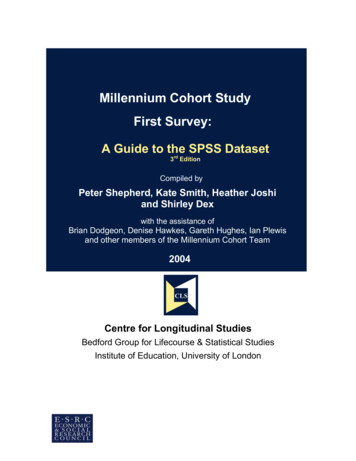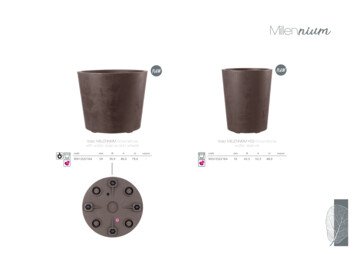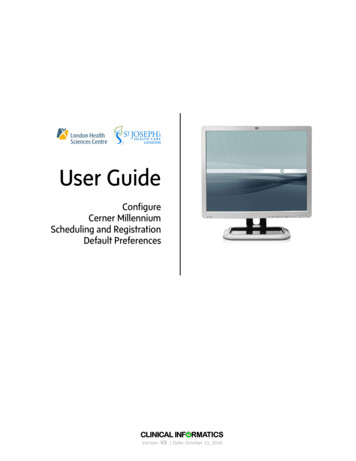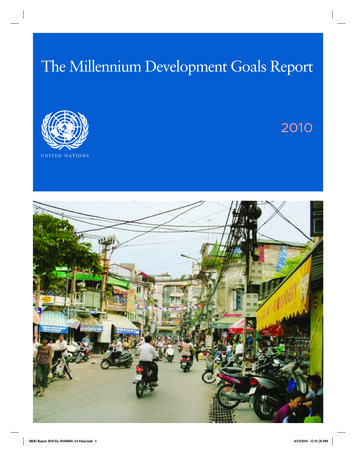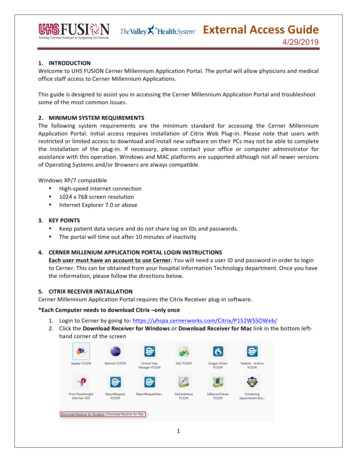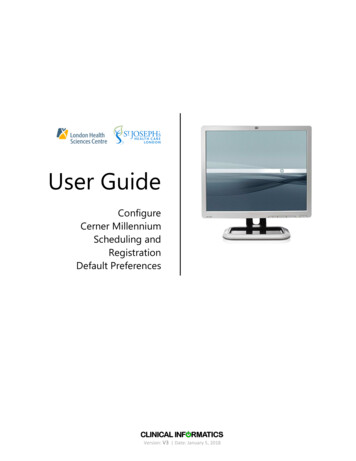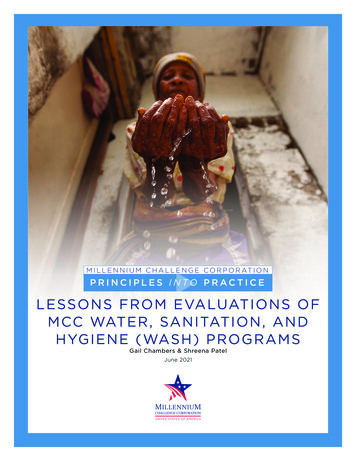
Transcription
M I L L E N N I U M C H A L L E N G E C O R P O R AT I O NPRINCIPLES INTO PRACTICEL E SS O N S F R OM E VA LUATI O N S OFM CC WAT E R, SA N I TATI O N , A N DHYG IE NE ( WASH) P R O G R A MSGail Chambers & Shreena PatelJune 2021
M I L L E N N I U M C H A L L E N G E C O R P O R AT I O NPRINCIPLES INTO PRACTICEThe Millennium Challenge Corporation’s mandate is to reduce poverty through economic growth. MCC works with a select number of developing countries that demonstrate a commitment to good governance and sound economic and social policies wherethe opportunity for economic growth and poverty reduction is greatest. MCC’s model reflects a set of principles that the UnitedStates—and many other donors and advocates—agree are required for development assistance to work well: country ownership, anevidence-based approach, focus on results, and transparency.MCC’s Principles into Practice series offers a frank look at what it takes to apply these principles in day-to-day operations. MCChopes that capturing and sharing the experiences will help MCC and others learn and do better. https://www.mcc.gov/p-into-pAbout the cover: The Cabo Verde II Compact Fundo De Acesso Social provided Victoria Furtado with water inside of her home.Photo by: Kyle LaFerriere
M I L L E N N I U M C H A L L E N G E C O R P O R AT I O NPRINCIPLES INTO PRACTICECONTENTSIntroduction.1Typical WASH-Related Themes:.2Independent Evaluation Results. 4WASH Portfolio Results.10Lessons from MCC’s WASH Portfolio. 11Lesson 1: Understand the specific problem that a WASH program aims toresolve and focus interventions accordingly around a clear and realistic objective. . 11Lesson 2: The ability of a program to achieve and demonstrate success dependson data quality and availability, and these issues must be explored in programdevelopment. 16Lesson 3: Design for water sector sustainability and persistence of benefits. 21Implementation Lessons. 26Conclusion and Continued Learning. 28Lessons Summary. 29MCC WASH Learning Agenda.30Annex: Detailed Program Logic for Networked System. 32L E SS O N S F R O M EVALUATIO NS O F M CC WATE R , SA N ITATION , A N D HYGIEN E (WASH) PR OGR A MSI
M I L L E N N I U M C H A L L E N G E C O R P O R AT I O NPRINCIPLES INTO PRACTICEIILE SS O NS FRO M E VALUATION S OF MCC WATER , SA N ITATION , A N D HYGIEN E (WASH) PROGRA MS
M I L L E N N I U M C H A L L E N G E C O R P O R AT I O NPRINCIPLES INTO PRACTICEINTRODUCTIONThe Millennium Challenge Corporation (MCC) has invested approximately 1.4 billion in water, sanitation,and hygiene (WASH) programs since the agency was founded in 2004.1 As summarized below, past investments spanned 13 countries and successfully constructed water supply systems, water treatment plants, waterdistribution networks, and wastewater collection and treatment systems. In addition to critical infrastructureinvestments, these programs also funded policy and institutional reforms such as community awareness andtraining and capacity building for water utilities. There are ongoing or planned WASH investments in anotherthree countries.1This total reflects MCC’s expenditures and commitments in WASH as of May 2021, a small portion of which is not referenced in this paper. WASH (orWaSH) is an acronym that stands for “water, sanitation, and hygiene.” Several international development agencies assert that attention to WASH can also improvehealth, life expectancy, student learning, gender equality, and other important issues of global development. For the purpose of this publication, WASH encompasses all of the investments that MCC has undertaken in water supply, sanitation, and drainage, regardless of the intended program outcomes.L E SS O N S F R O M EVALUATIO NS O F M CC WATE R , SA N ITATION , A N D HYGIEN E (WASH) PR OGR A MS1
M I L L E N N I U M C H A L L E N G E C O R P O R AT I O NPRINCIPLES INTO PRACTICEIn the early years of program development, WASH programs proposed by the agency’s partner countries werelargely guided by the Millennium Development Goals, which targeted increased access to improved watersources in rural areas and increased water system supply and access to the network in urban areas. With theintroduction of the Constraints Analysis in 2009 as a standard diagnostic tool to guide MCC funding, proposed programs shifted to an urban focus, where investments in water supply infrastructure (not necessarilynetwork access) had the potential for higher economic impact than in rural areas.2 Looking at the portfolio asa whole, MCC’s WASH interventions resulted from one, or a combination, of three themes, which are enumerated below. A simplified program logic summarizing typical outputs and potential outcomes is providedfor each theme; these outcomes also reflect the universe of potential economic benefits that MCC currentlymodels in its WASH cost-benefit analysis.3 The likelihood of achieving these outcomes depends on the intervention’s outputs, the country context, and the alignment between the problem and solution.TYPICAL WASH-RELATED THEMES4:THEME 1: Inadequate supply of, quality of, and/or access to waterSimplified Program LogicOUTPUTSWaterinfrastructureWAT E R SYS T E MO U TCO M E SWAT E R U S E RO U TCO M E SMore waterReducedwaterborne illnessCleaner d other)trainingMore accessiblewaterImproved hygieneand sanitationbehaviorsWater utilitystrengtheningMore reliable andaffordable waterserviceTime savings incollecting water andfrom less illnessCost savings fromcheaper water and lesshealth expenditureIncreased productivityof businessesusing waterIncreasedhousehold andbusiness incomes2The Constraints Analysis is the first stage of MCC’s compact or threshold program development process. A selected partner country begins the process with athorough analysis of its economy aimed at identifying the most serious impediments to economic growth through their impact on private investment and entrepreneurship. Mozambique was the first of MCC’s WASH programs to be motivated by a constraints analysis and all subsequent programs (Jordan through Mongolia II)were as well.WAT E R SYS T E MWAT E R U S E R3MCC’s M&E Policy defines an output as “The direct result of a Projectby the implementationof an Activity.” ItO UActivity.TCOTheMgoodsE S or services producedO U TCOMESdefines an outcome as “The likely or achieved intermediate effects of an intervention’s outputs.”4To determine which theme each MCC program focused on, refer to the MCC WASH Portfolio infographic above. Each theme corresponds to one of theactivity area icons, i.e., theme 1 relates to water infrastructure, 2 to sanitation infrastructure, and 3 to drainage infrastructure.Training in hygiene practices and/orReducedMore waterother related topics tends to be a complementary investment.2waterborne illnessLE SS O NS FRO M E VALUATION S OF MCC WATER , SA N ITATION , A N D HYGIEN E (WASH) PROGRA MSCleaner waterTime savings incollecting water andfrom less illness
M I L L E N N I U M C H A L L E N G E C O R P O R AT I O NPRINCIPLES INTO PRACTICETHEME 2: Inadequate access to sanitationSimplified Program iene(and other)trainingS A N I TAT I O NSYS T E MO U TCO M E SMore accessiblesanitation servicesCleanerenvironment/groundwaterImproved hygieneand sanitationbehaviorsWater utilitystrengtheningMore reliableand affordablesanitation serviceS A N I TAT I O NUSERO U TCO M E SReducedwaterborne illnessTime savings fromless illnessCost savings from lesshealth expenditureIncreasedhousehold incomesTHEME 3: Excessive economic losses caused by floodingSimplified Program LogicOUTPUTSD R A I N AG ESYS T E MO U TCO M E SFewer economiclosses from floodingDrainageinfrastructureDecreased floodingHygiene(and other)trainingInstitutionalstrengtheningCO M M U N I T YO U TCO M E SReducedwaterborne illnessTime savings fromless illnessCleanerenvironment/groundwater(when combinedwith sanitationimprovements)Cost savings from lesshealth expenditureIncreased householdand business incomesL E SS O N S F R O M EVALUATIO NS O F M CC WATE R , SA N ITATION , A N D HYGIEN E (WASH) PR OGR A MS3
M I L L E N N I U M C H A L L E N G E C O R P O R AT I O NPRINCIPLES INTO PRACTICEINDEPENDENT EVALUATION RESULTSThis paper reflects on what MCC has learned from its experience over the last 15 years in designing, implementing, and evaluating WASH programs. Independent evaluations constitute a significant source of learningbecause they objectively measure and assess the achievement of targeted outcomes for each program inwhich MCC invests. The evaluations focus on validating the theory of change or program logic elaborated inthe Compact or Threshold Program and related monitoring and evaluation (M&E) plan, which documentsthe results explicitly targeted by the program as well as benefit streams modeled in the cost-benefit analysisthat supported the investment decision. There is not always perfect alignment between the program’s statedobjective(s) and the results assessed and reported by the evaluations. This misalignment may be the result ofprogram design changes, measurement prioritization decisions, or measurement challenges.To date, 12 final evaluation reports and six interim evaluation reports for ongoing evaluations in the WASHsector have been published.5 The WASH evaluations measure results between 6 months and 6 years aftertarget beneficiaries’ exposure to the WASH interventions. The following section summarizes the findings of 17evaluations that reflect the most current set of results for each program, along with a brief description of theprogram interventions and objective(s) targeted and evaluated.6 Evaluations are presented chronologically inorder of the evaluated program’s implementation timeline.GEORGIA I Regional InfrastructureRehabilitation ProjectRegional Infrastructure Development ActivityWater and Sanitation Sub-Activity URBAN5Municipalities granted fundingfor water supply and wastewatercollection projectsThe Georgia I Compact’s Regional Infrastructure Development Activity aimed to make grants to national andsub-national government units and municipal utilities to achieve the broader project objective of rehabilitating key regional infrastructure. The planned impact evaluation had to be canceled due to changes in theprogram and methodological challenges in the evaluation, and, as such, there are no evaluation results. Afterthis cancellation, MCC commissioned an independent cost-benefit analysis, which resulted in an estimatedeconomic rate of return (ERR) of between 0.7 and 2.5 percent for the program (versus the original MCC estimate of 11.6 percent). This range falls below MCC’s investment threshold of 10 percent.75Evaluations of eight of the 13 completed WASH programs have concluded, while Cabo Verde II, Liberia, Sierra Leone, and Zambia evaluations are ongoing;the evaluation for Mongolia II has not begun. Depending on the program logic, there may be more than one evaluation for a given program. While the IndonesiaCommunity-Based Health and Nutrition Project included a hygiene and sanitation component, the evaluation results are not presented here because WASH wasjust one of many health-focused interventions.6The italicized text in the evaluation summaries reflects either the official Project Objective or a description of the aims of the Activity or Sub-Activity.7Readers may be familiar with cost-benefit analysis, which compares the benefits expected from an investment to its cost. The economic rate of return (ERR)is a summary statistic produced in the analysis, which reflects the potential economic benefits of a proposed investment. A project is considered a sensible economic investment when the estimated ERR is higher than the local discount rate for capital. In most developing countries, one would expect that discount rate to benear or above 10 percent and this is the hurdle rate that MCC applies when considering investments.4LE SS O NS FRO M E VALUATION S OF MCC WATER , SA N ITATION , A N D HYGIEN E (WASH) PROGRA MS
M I L L E N N I U M C H A L L E N G E C O R P O R AT I O NPRINCIPLES INTO PRACTICEEL SALVADOR I Human DevelopmentProjectWater and Sanitation Sub-ActivityRURAL45157,634water and community household cted constructed campaignprovidedconstructedThe El Salvador I Compact’s Water and Sanitation Sub-Activity aimed to increase coverage of water supplyand sanitation facilities in order to achieve the objective of increasing human and physical capital of residentsof the Northern Zone to take advantage of employment and business opportunities. The impact evaluationconfirmed that access to water and improved sanitation had improved and that time spent collecting waterdecreased by approximately 26 minutes per day per household, relative to the comparison group. However,there was no overall increase in water consumption and no evidence of increased time spent on incomeearning activities. Similarly, there was no evidence of impact on school enrollment or attendance, nor on thediarrhea rate among children under age five. Finally, the evaluation found no impact on household income.GHANA I Rural Development ProjectWater and Sanitation Sub-ActivityRURAL392water points constructedor rehabilitatedThe Ghana I Compact’s Water and Sanitation Sub-Activity aimed to reduce the distance to water and sanitation facilities and reduce the incidence of guinea worm, diarrhea, or bilharzia. This sub-activity supported thebroader project objective to strengthen the rural institutions that provide services complementary to, and supportive of, agricultural and agri-business development. The impact evaluation confirmed that time spent collecting water decreased by 13 minutes per day per household, relative to the comparison group, and that water quality from the improved water sources was better than surface water. However, the program did not significantlyincrease water consumption or affect the price paid for water. The evaluation was not able to detect if the hygieneand sanitation training had an effect on handwashing. While there was a reduction in diarrhea in children underfive, it could not be attributed to the program. Finally, the evaluation found no impact on household income.TANZANIA Water Sector ProjectLower Ruvu Plant Expansion &Morogoro Water Supply ActivitiesURBAN2 treatment plants upgraded1 new treatment plant constructedIncreased production capacity by100 million liters of water per dayThe Tanzania Compact’s Water Sector Project objective was to increase investment in human and physicalcapital and reduce the prevalence of water-related disease. The impact evaluation of the Morogoro WaterSupply Activity found that while the quantity and quality of water supplied to the water network increased,continuity of service to customers decreased due to utility rationing to provide more equitable service acrossthe growing customer base that was independent of the program. Since intermittency in water supply persisted for customers, the evaluators concluded that effects on investment in physical and human capital andwater related diseases were unlikely to have been achieved during the study period. The evaluation was unableto assess impacts on household income.L E SS O N S F R O M EVALUATIO NS O F M CC WATE R , SA N ITATION , A N D HYGIEN E (WASH) PR OGR A MS5
M I L L E N N I U M C H A L L E N G E C O R P O R AT I O NPRINCIPLES INTO PRACTICEThe impact evaluation of the Lower Ruvu Plant Expansion Activity concluded that access to piped water hadincreased in Dar es Salaam, at least in part due to the program. Households that had newly connected to thepiped water network consumed more water than unconnected households and saved one-and-a half hours perweek in time spent collecting water. The evaluation did not find definitive evidence of a reduction in diarrheaor an increase in household income as a result of the program.MOZAMBIQUE Water andSanitation ProjectRural Water Supply ActivityRURAL615 boreholesconstructed8,400 peopletrained inhygiene andsanitary bestpracticesThe Mozambique I Compact’s Rural Water Supply Activity aimed to support the broader water projectobjective of increasing the accessibility, reliability, and quality of water and sanitation services. The impactevaluation confirmed that access to higher quality water had improved in program areas, relative to comparison areas, and that water consumption from safer water sources increased by 16.7 liters per capita perday. Water collectors reported time savings of 55 minutes per each 20 liters of water collected. Communitybased training failed to impact sanitation and handwashing behavior. Finally, the evaluation found noimpact on household income.MOZAMBIQUE Water andSanitation ProjectUrban Water Supply and Drainage andSanitation Activities URBANMunicipal water supply anddrainage systems upgraded.3,9584Technical support for nationalreforms provided.The Mozambique I Compact’s Urban Water Supply and Drainage and Sanitation Activities aimed to supportthe broader water project objective of increasing the accessibility, reliability, and quality of water and sanitation services. The performance evaluation found that the water distribution investments in Nampula had contributed to increased water service hours, but broader benefits for customers were constrained by insufficientwater supply. The dam construction in Nacala had not produced benefits because complementary investmentsin treatment and distribution that were not completed during the compact had not been continued by thegovernment. Though there was a perceived reduction in flooding in the cities where drains were installed, thisdid not seem to have affected the prevalence of malaria. Finally, the remaining set of works in Mocuba couldnot be assessed by the evaluation because they were severely damaged in a flood after the compact ended.6LE SS O NS FRO M E VALUATION S OF MCC WATER , SA N ITATION , A N D HYGIEN E (WASH) PROGRA MS
M I L L E N N I U M C H A L L E N G E C O R P O R AT I O NPRINCIPLES INTO PRACTICELESOTHO Water Sector ProjectRural Water Supplyand Sanitation ActivityRURAL29,000latrinesconstructed175water systemsconstructedThe Lesotho I Compact’s Rural Water Supply and Sanitation Activity aimed to support the broader waterproject objective to improve the water supply for industrial and domestic needs and enhance urban andrural livelihoods through improved watershed management. The impact evaluation confirmed that accessto improved water and improved toilets had increased relative to comparison areas. In addition, time spentcollecting water had decreased by 44 minutes per day. However, no impacts were detected on water-relatedillness or household income.Water treatment plant constructed,water supply and distributioninfrastructure upgraded, and 2,312households given provisions toconnect to the water networkLESOTHO Water Sector ProjectUrban and Peri-Urban WaterActivity URBANThe Lesotho I Compact’s Metolong Dam program and Urban and Peri-Urban Water Activity aimed to support the broader water project objective to improve the water supply for industrial and domestic needs andenhance urban and rural livelihoods through improved watershed management. In studying the investment inthe Metolong Dam, the impact evaluation found no impact on water supply reliability relative to comparisongroups and did not detect impacts on time savings, water collection, water consumption, diarrheal illness, orwater expenditures. Related to the other works on the water network, the evaluation found that newly connected households experienced significant time savings, increased water consumption, and decreased watercollection, relative to unconnected households. The choice to connect to the water system cannot be directlyattributed to the program. The evaluation also found that water expenditures increased where the entire pipedwater network was new. There was no impact detected on diarrhea in children under the age of five.JORDAN CompactWater Network ProjectWastewater Network ProjectAs-Samra Expansion Project1,160 km ofwater networkconstructedAs-Samra watertreatment plantexpandedURBANWastewatersystemextended tonew customersThe Jordan Compact focused entirely on the water sector and its objective was to increase the effective supplyof water available to the inhabitants of Zarqa Governorate through improvements in the efficiency of waterdelivery, the extent of wastewater collection, and the capacity of wastewater treatment. Three projects supported this objective. The objectives of the Water Network Project were to (i) improve the efficiency of networkwater delivery and the condition of home water systems, and (ii) decrease certain costs that households inZarqa Governorate incur to satisfy their subsistence water needs. The objectives of the Wastewater NetworkProject were to (i) increase access to the wastewater network, (ii) increase the volume of wastewater collectedwithin Zarqa Governorate for treatment and reuse, and (iii) reduce the incidents of sewage overflow. Finally,the objectives of the As-Samra Expansion Project were to (i) increase the capacity to treat wastewater fromAmman and Zarqa Governorates, (ii) increase the volume of treated wastewater that is available as aL E SS O N S F R O M EVALUATIO NS O F M CC WATE R , SA N ITATION , A N D HYGIEN E (WASH) PR OGR A MS7
M I L L E N N I U M C H A L L E N G E C O R P O R AT I O NPRINCIPLES INTO PRACTICEsubstitute for freshwater for non-domestic use, and (iii) protect existing agriculture from the potential consequences of pollution from untreated wastewater.The impact evaluation confirmed that the program had successfully expanded Zarqa’s sewer network andthereby increased the volume of wastewater flowing to the As-Samra treatment plant and reducing theamount of freshwater that needed to be supplied to the Jordan Valley for agricultural purposes. This allowedfor 3-5 million cubic meters per year of additional freshwater to be sent to urban areas. While there was someindication of an increase in water consumption among urban customers, they did not switch away from othersources to piped water. Regarding the objective of more efficient water delivery, the evaluation concluded thatthe compact had helped to improve the Zarqa water utility’s performance. However the reduction in nonrevenue water lagged expectations.JORDAN Water Network ProjectWater Smart Homes ActivityURBAN3,958HHs provided mpaignimplemented30 womenplumberstrainedThe Jordan Compact’s Water Smart Homes Activity supported the Water Network Project objective notedabove, specifically to improve the condition of home water systems and decrease certain costs that households in Zarqa Governorate incur to satisfy their subsistence water needs. The performance evaluation didnot detect an effect of the outreach campaign on household water handling or water sourcing. Householdsthat had received household water infrastructure did not appear to use more piped water relative to nontargeted households and there was no evidence of changes in household water-related costs, productivity,health, or well-being. Finally, more than half of the women trained to become plumbers were still workingin the profession after the compact and may have increased incomes as a result, though this could not beattributed to the program.CABO VERDE WASH ProjectNational Policy and Institutional Reform ActivityUtility Reform ActivityInfrastructure Grant Activity URBAN 20MTechnical assistanceprovided to supportutility reformGrant funding providedto support municipalwater worksThe Cabo Verde II Compact’s Water, Sanitation, and Hygiene Project objective was to establish a financiallysound, transparent, and accountable institutional basis for the delivery of water and sanitation services toCabo Verdean households and firms by: (i) reforming national policy and regulatory institutions; (ii) transforming inefficient utilities into autonomous corporate entities operating on a commercial basis; and (iii)improving the quality and reach of infrastructure in the sector. At the interim stage, the performance evaluation found that the national and institutional reform efforts had successfully consolidated the regulatory entities and passed critical reforms into law. A new water utility, Aguas de Santiago, had been created, though laterthan planned, and continued to require external technical assistance. The infrastructure grants and connectionsubsidies contributed to increased access to the piped water and sanitation networks, but they did not result intime savings for water users. The final evaluation is forthcoming.8LE SS O NS FRO M E VALUATION S OF MCC WATER , SA N ITATION , A N D HYGIEN E (WASH) PROGRA MS
M I L L E N N I U M C H A L L E N G E C O R P O R AT I O NPRINCIPLES INTO PRACTICE ZAMBIA CompactPortions of waterLusaka Water Supply, Sanitation,URBAN infra. backbone inLusakaand Drainage Project URBANrehabilitatedTechnicalassistanceprovidedGrant funding providedto support access towater, sanitation, anddrainage serviceThe Zambia Compact focused entirely on the water sector with the following objectives: to expand access to,and improve the reliability of, water supply and sanitation, and improve drainage services in select urban andperi-urban areas of the city of Lusaka in order to decrease the incidence of water-borne and water-related diseases, generate time savings for households and businesses, and reduce non-revenue water in the water supplynetwork. Five evaluations were undertaken to assess the broad-ranging compact investments: the first focusedlargely on institutional reform efforts; the second on the infrastructure efforts (but only a water quality studycould be continued after the baseline stage due to methodological issues and changes in program implementation); and the third through fifth focused on a grant-giving mechanism known as a grant facility.At the interim stage, the performance evaluation of the Lusaka Water Supply, Sanitation, and DrainageProject, (or the entire compact), found that infrastructure works were not yet completed one year after thecompact ended. The project’s technical assistance had enabled Lusaka Water and Sewerage Company (LWSC)to adopt new policies and practices to improve asset management, but the utility was not yet maximizingthe benefits of this support. The evaluation noted that residents and businesses along the primary drains hadperceived a reduction in flooding, but that the usefulness of these drains is limited without secondary drains.The compact had supported the development of a solid waste management utility to prevent blockage of thedrains, but this utility had not yet been formed.The interim performance evaluation of the Municipal Utility Operations Monitoring Sub-Activity, whichposited that improved water supply and sanitation would result in improved water quality and reduced waterrelated diseases, found some evidence of an improvement in water quality through a reduction in E. coli, butnoted that challenges remain. The evaluation confirmed that wastewater treatment at the improved facility istaking place effectively.The Zambia Compact’s Innovation Grants Sub-Activity intended to support innovative opportunities andpartnerships in the water, sanitation, and solid waste management sectors in support of the broader programobjectives. The overarching grant program’s performance evaluation found that the program’s implementation veered from the original model and grantees were often delayed, but communities perceived positiveeffects, particularly on drainage and solid waste management. The performance evaluation of the “SmartSafe Water Supply Scheme-Scaling Up” grant project found that water access in peri-urban areas of Lusakaimproved but remained uneven. The performance evaluation of the Zambian Breweries’ Manja Pamodzigrant project reported that respondents perceived a reduction in waste, risk of cholera, and blockage ofdrains in their communities as a result of the program.L E SS O N S F R O M EVALUATIO NS O F M CC WATE R , SA N ITATION , A N D HYGIEN E (WASH) PR OGR A MS9
M I L L E N N I U M C H A L L E N G E C O R P O R AT I O NPRINCIPLES INTO PRACTICEWASH PORTFOLIO RESULTSThese evaluations report mixed results across MCC’s WASH portfolio. Program activities were generallycompleted as planned and the infrastructure installed was generally functioning as expected. However, theexpected benefits to households and businesses mostly did not materialize, particularly the posited red
MCC's Principles into Practice series offers a frank look at what it takes to apply these principles in day-to-day operations. MCC . mate of 11.6 percent). This range falls below MCC's investment threshold of 10 percent.7 5 Evaluations of eight of the 13 completed WASH programs have concluded, while Cabo Verde II, Liberia, Sierra Leone .
